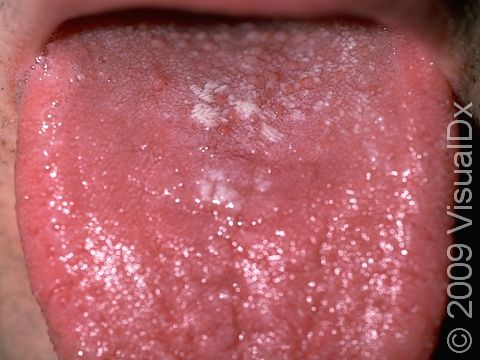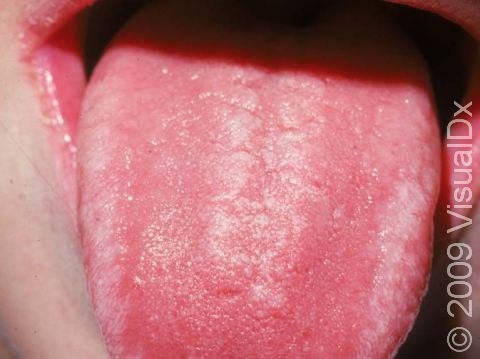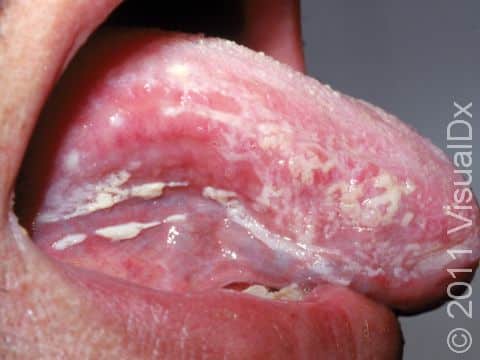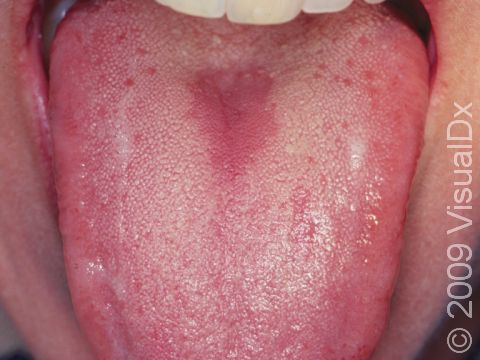Thrush (Oral Candidiasis)
Oral candidiasis, commonly known as thrush, is a yeast infection of the mouth or throat. The yeast that most commonly causes oral candidiasis is Candida albicans.
Who's At Risk?
Thrush is most common in infants. However, anyone of any age group can develop thrush. Adults or teens who develop thrush most often include those:
- With diabetes or other glandular (endocrine) disorders.
- Who wear dentures.
- Taking antibiotics.
- Undergoing chemotherapy.
- Who abuse drugs.
- With poor nutrition.
- Who have an immune deficiency, such as HIV.
- Who use inhaled steroids for certain lung conditions.
- Who are pregnant or on birth control pills.
Signs & Symptoms
Thrush may appear as white or pale-yellow papules (raised, solid bumps) or plaques (flat, solid areas) on the inner surfaces of the mouth and throat, the tongue, and the lips. It may resemble cottage cheese or milk curds. Scraping off these membranes may be difficult and may leave slightly bleeding sores. Thrush can sometimes appear as red, sore areas.
Thrush may be associated with a burning sensation in the mouth or throat.
Self-Care Guidelines
Thrush may make eating and drinking uncomfortable, and people with thrush may become dehydrated. It is important to maintain good nutrition and hydration while infected with thrush.
Thrush requires medication prescribed by a medical professional.
Good oral and dental hygiene are important measures in treating and preventing thrush, including cleaning the teeth and tongue every morning and night, as well as after every meal. For those who wear dentures, it is similarly important to regularly clean your dentures and to remove dentures at night, submerging them nightly in disinfectant liquid.
Treatments
In addition to meticulous oral hygiene practices, the medical professional will recommend treatment to help kill the overgrown yeast using antifungal medications, such as:
- Nystatin rinse – Nystatin comes in a suspension, or liquid, and in a lozenge, also called a troche. The suspension is swished around the mouth and then swallowed. The lozenge dissolves in the mouth. Both the suspension and the lozenges are used several times a day until the lesions are completely gone.
- Amphotericin B suspension – The suspension is swished and swallowed several times a day until the lesions are completely gone.
- Clotrimazole lozenge – A lozenge is dissolved in the mouth several times a day until the lesions are completely gone.
- Fluconazole pill – This medication is swallowed once daily for 5-10 days.
Visit Urgency
Thrush requires prescription medication, so it is important to see a medical professional if you suspect you have thrush. It is particularly important for people with an immune system deficiency to get prompt medical care and treatment for thrush, to ensure the yeast does not enter the bloodstream or infect other organs.
References
Bolognia J, Schaffer JV, Cerroni L. Dermatology. 4th ed. Philadelphia, PA: Elsevier; 2018.
James WD, Elston D, Treat JR, Rosenbach MA. Andrew’s Diseases of the Skin. 13th ed. Philadelphia, PA: Elsevier; 2019.
Kang S, Amagai M, Bruckner AL, et al. Fitzpatrick’s Dermatology. 9th ed. New York, NY: McGraw-Hill Education; 2019.
Paller A, Mancini A. Paller and Mancini: Hurwitz Clinical Pediatric Dermatology. 6th ed. St. Louis, MO: Elsevier; 2022.
Last modified on June 17th, 2024 at 9:41 am

Not sure what to look for?
Try our new Rash and Skin Condition Finder




